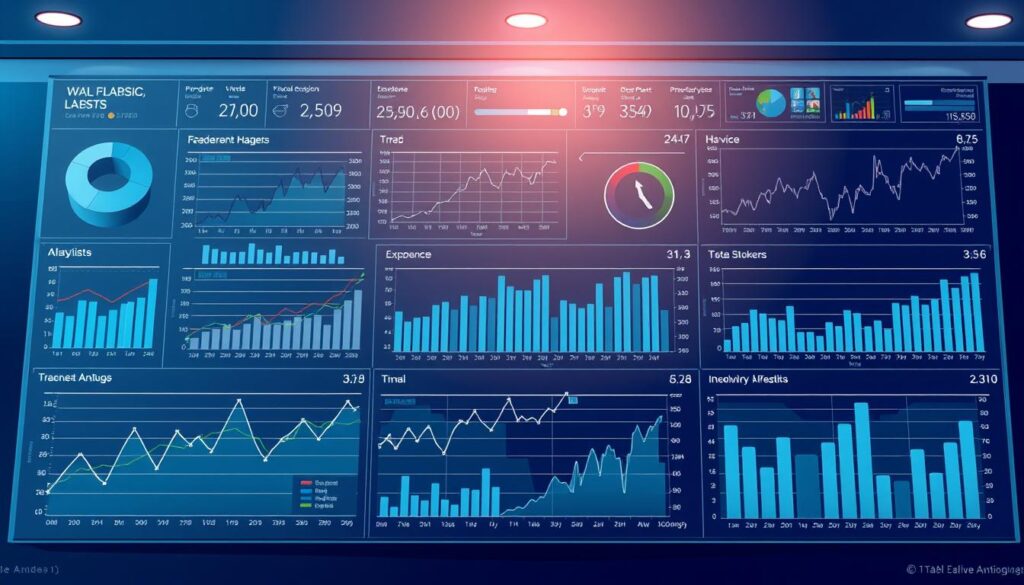Artificial Intelligence (AI) is reshaping industries, and the financial world is no exception. With its ability to analyze vast amounts of data in real-time, AI is becoming a game-changer for investors. Whether you’re new to the market or looking to refine your strategies, AI offers tools to enhance your decision-making process.
This guide is designed to help you understand how AI can transform your approach to investing. From predicting price movements to identifying trends, AI provides actionable insights that were once out of reach for most. By leveraging these tools, you can make informed decisions at the right time, giving you a competitive edge.
Stay tuned as we explore practical applications and step-by-step strategies to help you get started. Whether you’re curious about data analysis or portfolio optimization, this guide will equip you with the knowledge to succeed.
Introduction to AI in Stock Market Investing
The rise of AI is revolutionizing how investors approach the financial markets. By leveraging advanced algorithms, AI can analyze vast amounts of data in real-time, providing insights that were once impossible to achieve manually. This tool is transforming the way decisions are made, offering a competitive edge to those who embrace it.
Understanding AI’s Impact on Finance
AI has become a game-changer in finance. It processes millions of data points daily, uncovering patterns and trends that humans might miss. Companies like Nvidia and Microsoft are leading the charge, developing technologies that enhance performance and efficiency. For investors, this means more accurate predictions and better-informed decisions.
Traditional strategies are evolving as AI automates routine tasks. This allows you to focus on higher-level analysis, saving time and reducing errors. The result is a more streamlined approach to investment management, backed by data-driven insights.
Why AI is Transforming Stock Picks
AI tools are reshaping how stocks are selected and analyzed. By automating data collection and analysis, these tools provide actionable insights faster than ever before. For example, platforms like Moomoo Canada use AI to predict market trends with over 85% accuracy, giving users a significant advantage.
However, integrating AI into your strategy isn’t without challenges. While it reduces emotional biases and improves decision-making, it also requires a solid understanding of the technology. This guide will help you navigate these complexities, ensuring you make the most of AI’s potential.
From real-time market updates to personalized portfolio management, AI is making sophisticated strategies accessible to all. By embracing this technology, you can enhance your performance and stay ahead in the ever-changing financial landscape.
Machine Learning Stock Picks: A Beginner’s Guide to AI-Powered Investing
Modern technology is reshaping the way we analyze and predict market trends. One of the most impactful advancements is the use of advanced algorithms to process vast amounts of data. These tools can uncover patterns in historical stock price movements, providing actionable insights for investors.
What is Machine Learning in Finance?
Machine learning involves training algorithms to learn from historical data. In finance, this means analyzing past stock market trends to predict future movements. By identifying patterns, these models can help you make informed decisions based on data rather than intuition.
Platforms like Google Colab make it easy to set up and run these models. With Python libraries, you can quickly build and test algorithms without needing extensive coding knowledge. This accessibility is a game-changer for new investors.
Advantages for New Investors
Using machine learning techniques offers several benefits. First, it helps spot trends that might be invisible to the human eye. Second, it reduces errors by relying on data-driven information rather than emotional biases. This leads to more accurate predictions and better outcomes.
For example, platforms like Moomoo Canada use these tools to predict market trends with high accuracy. This gives users a competitive edge, especially in volatile markets. By embracing these technologies, you can enhance your investment strategies and stay ahead of the curve.
In summary, machine learning is transforming how we approach the stock market. From analyzing historical data to predicting future trends, these tools provide valuable information that can improve your decision-making process. Whether you’re new to investing or looking to refine your strategies, these technologies offer a powerful way to succeed.
Setting Up Your AI Environment for Stock Analysis
Setting up an AI environment for stock analysis doesn’t have to be complicated. With the right tools and platforms, you can create a system that simplifies data processing and enhances your decision-making. This section will guide you through the essentials, focusing on Google Colab and other key resources.
Getting Started with Google Colab
Google Colab is a cloud-based platform that makes it easy to set up your AI environment. It comes with pre-installed libraries like pandas, numpy, and TensorFlow, saving you time on configuration. This is especially helpful for beginners who want to dive into data analysis without technical hurdles.
To start, simply open Google Colab in your browser. Create a new notebook, and you’re ready to import libraries and begin your project. The platform also supports collaborative work, allowing you to share notebooks with others for feedback or teamwork.
Essential Tools and Libraries
When building your AI environment, certain tools are indispensable. Python is the go-to programming language for data analysis, thanks to its simplicity and extensive libraries. TensorFlow is another essential tool, enabling you to build and train models efficiently.
Visualization libraries like matplotlib help you interpret datum by creating charts and graphs. These tools work seamlessly within Google Colab, making it a one-stop solution for your AI needs. By leveraging these resources, you can focus on extracting insights rather than managing technical details.
In summary, setting up your AI environment is a straightforward process with the right technology. Google Colab, combined with essential tools, provides a powerful foundation for your stock analysis journey. Whether you’re a beginner or refining your skills, this setup ensures you’re equipped to succeed.
Acquiring and Preparing Stock Market Data for AI
Data is the backbone of any successful AI-driven strategy in the financial world. Without accurate and well-prepared data, even the most advanced algorithms fall short. This section will guide you through the essential steps to collect, clean, and normalize data for optimal performance.

Data Collection with Google Finance and Yahoo
To start, you need reliable sources for stock market data. Platforms like Google Finance and Yahoo Finance are excellent options. Using the GOOGLEFINANCE function in Google Sheets, you can pull historical prices, trading volumes, and other key metrics directly into your spreadsheet.
Once you’ve gathered the data, export it to a CSV file. This format is compatible with Python and other programming languages, making it easy to process further. These tools simplify the step of data acquisition, saving you time and effort.
Cleaning and Normalizing Your Data
Raw data often contains missing values or anomalies that can skew your results. Cleaning involves identifying and addressing these issues. For example, you might fill in missing values using averages or remove rows with incomplete information.
Next, normalization ensures all features are on a similar scale. Tools like scikit-learn’s MinMaxScaler are invaluable here. They transform data into a 0-1 range, making it easier for your model to process. This trend of scaling data is crucial for accurate predictions.
By following these steps, you can transform complex data into actionable insights. Proper preparation ensures your AI model performs at its best, giving you a competitive edge in the market.
Implementing LSTM Models for Stock Price Prediction
Long Short-Term Memory (LSTM) networks are revolutionizing how we predict financial trends. These models excel at analyzing time-series data, making them ideal for forecasting stock prices. By understanding their architecture and process, you can leverage this tech to enhance your investment strategy.
Overview of LSTM Architecture
LSTM networks are designed to remember information over extended periods. They consist of input, hidden, and output layers. The input layer receives data, while the hidden layers process it using memory cells and gating mechanisms. This structure allows LSTMs to capture sequential dependencies in stock market data effectively.
Unlike traditional models, LSTMs handle non-linear relationships and long-term trends. This makes them a powerful tool for predicting price movements. By understanding this architecture, you can better appreciate how LSTMs improve forecasting accuracy.
Training and Testing Your LSTM Model
To train an LSTM model, you’ll need Python and TensorFlow. Start by compiling the model with the Adam optimizer. Use dropout layers to prevent overfitting, ensuring your model generalizes well to new data. This process is crucial for achieving reliable predictions.
Next, split your dataset into training and testing sets. Train the model on 80% of the data and reserve the remaining 20% for evaluation. This strategy helps you assess the model’s performance accurately. Finally, test the model by comparing predicted prices to actual values.
By following these steps, you can build a robust LSTM model tailored to your needs. This tech empowers you to make data-driven decisions, giving you a competitive edge in the market.
Evaluating Your AI Model Performance: Metrics and Techniques
Evaluating your AI model’s performance is a critical step in refining your investment strategy. By understanding how well your model predicts outcomes, you can make informed adjustments to improve accuracy. This section explores key metrics and visualization techniques to assess your model’s effectiveness.
Understanding RMSE, MAE, and Other Metrics
Root Mean Square Error (RMSE) and Mean Absolute Error (MAE) are essential metrics for evaluating prediction accuracy. RMSE measures the average difference between predicted and actual values, while MAE calculates the absolute error. Both provide insights into how well your model performs.
For example, a lower RMSE indicates higher accuracy. These metrics help you identify areas for improvement, ensuring your model delivers reliable results. By focusing on these features, you can refine your approach and enhance your trading decisions.
Visualizing Predictions vs. Actual Stock Prices
Visualization tools like Matplotlib allow you to compare predicted and actual stock prices. Creating line charts or scatter plots helps you spot discrepancies and trends. This process provides a clear picture of your model’s performance.
For instance, if predictions consistently deviate from actual prices, you may need to adjust your model’s parameters. Visualizing data ensures you make data-driven decisions, improving your trading strategy over time.
Accurate performance evaluation is crucial for refining and improving models. By leveraging these techniques, you can ensure your AI tools deliver actionable insights, giving you a competitive edge in the market.
Enhancing Analysis with Additional AI Tools
AI tools are transforming how we approach complex tasks in finance. Beyond traditional methods, platforms like ChatGPT and Google Bard are making advanced techniques accessible to everyone. These tools provide real-time support, helping you streamline your analysis and improve accuracy.
Leveraging ChatGPT for Coding Guidance
ChatGPT serves as a conversational assistant for coding and debugging. Whether you’re working in Python or troubleshooting a model, it offers step-by-step guidance. This platform simplifies complex tasks, making it ideal for those new to coding.
For example, if you encounter an error in your script, ChatGPT can explain the issue and suggest fixes. This real-time support ensures you stay on track, even when dealing with advanced algorithms. By integrating this tool, you can focus on refining your approach rather than getting stuck on technical details.
Utilizing Google Bard for Technical Assistance
Google Bard is another powerful platform for technical assistance. It helps you enhance model development by providing insights and solutions to common challenges. Whether you’re optimizing parameters or interpreting results, Bard offers valuable support.
This tool is particularly useful for beginners, as it breaks down complex concepts into easy-to-understand steps. By leveraging Bard, you can improve your approach to analysis and make more informed decisions. Together, these tools create a seamless workflow, saving time and effort.
Integrating advanced AI tools like ChatGPT and Google Bard into your process can significantly enhance your analysis. They provide practical support, making sophisticated techniques accessible to all. Whether you’re following a beginner guide or refining your skills, these platforms ensure you stay ahead in the ever-changing financial landscape.
Integrating Visualization Tools: Tableau and Beyond
Visualizing data effectively can transform complex predictions into actionable insights. By leveraging tools like Tableau, you can turn raw numbers into compelling visual narratives. This ability is a game-changer, especially when dealing with intricate datasets. It allows you to identify trends and patterns quickly, making your analysis more efficient.

Creating Visual Narratives of Your Data
Tableau excels at transforming data into interactive dashboards. These dashboards provide a clear view of your research, highlighting key trends and anomalies. For example, you can use color-coded charts to show price movements or heat maps to identify market hotspots. This advancement in visualization makes it easier to communicate insights to stakeholders.
Interactive features allow you to drill down into specific data points. This ability ensures you can explore every factor influencing your predictions. By creating story-driven dashboards, you can present your findings in a way that resonates with both technical and non-technical audiences.
Exporting and Sharing Predictions
Once your visualizations are complete, exporting them is straightforward. Tableau supports formats like CSV and hyper files, making it easy to share your work. This advancement ensures your predictions can be integrated into other tools for further analysis.
Sharing visualizations with stakeholders is equally simple. You can publish dashboards directly to Tableau Server or export them as PDFs. This ability to share insights in real-time enhances collaboration and decision-making. It also ensures everyone stays on the same page, regardless of their technical expertise.
Combining analytical insights with effective storytelling is a powerful factor in financial analysis. Tools like Tableau make this process seamless, helping you stay ahead in a competitive landscape. By mastering these techniques, you can elevate your research and make data-driven decisions with confidence.
Balancing Technical and Fundamental Analysis in AI Investing
Combining technical and fundamental analysis can significantly improve your investment strategy. While technical analysis focuses on price movements and trading volume, fundamental analysis examines a company’s financial health and growth potential. Together, they provide a comprehensive way to evaluate opportunities in the market.
Incorporating Technical Analysis Techniques
Technical analysis uses tools like moving averages (SMA/EMA) to identify trends and patterns. These methods are particularly useful for short-term trading decisions. For example, analyzing trading volume can help you spot potential entry and exit points. This way of processing data allows you to act quickly on market signals.
By focusing on historical price data, technical analysis helps you predict future movements. This approach is ideal for traders who rely on timing and market conditions. However, it’s important to complement these insights with a broader perspective.
Complementing with Fundamental Insights
Fundamental analysis provides a long-term view of a company’s performance. It examines factors like earnings reports, revenue growth, and industry trends. This method is essential for investors who prioritize stability and growth over quick gains.
For instance, analyzing a company’s financial statements can reveal its potential for future success. This processing of finance data ensures you make informed decisions based on solid evidence. Combining this with technical analysis creates a balanced approach to investing.
By integrating both methods, you can achieve a more holistic understanding of the market. This dual approach minimizes risks and maximizes opportunities, giving you a competitive edge in your investment journey.
Managing Risks and Ethical Considerations in AI Investing
While AI offers powerful tools for investing, it also introduces unique challenges that demand careful management. From market volatility to ethical dilemmas, understanding these risks is essential for making informed decisions. This section explores how to navigate these complexities effectively.
Understanding Volatility and Market Risks
Market volatility can significantly impact the performance of AI-driven models. Unexpected events, such as economic shifts or geopolitical tensions, can disrupt even the most accurate predictions. For example, tech-heavy stocks often experience sharp price swings, which can challenge the reliability of your model.
To mitigate these risks, diversify your portfolio and avoid over-reliance on a single prediction. Regularly update your data inputs to reflect real-time market conditions. This approach ensures your strategies remain adaptable in a dynamic environment.
Exploring Legal and Ethical Implications
AI in finance also raises important legal and ethical questions. For instance, using AI to analyze a company‘s data must comply with privacy regulations like GDPR. Failure to do so can result in legal penalties and reputational damage.
Ethical considerations are equally critical. Ensure your AI tools are transparent and free from biases. Regularly audit your algorithms to maintain fairness and accountability. Staying updated with regulatory changes is crucial for long-term success.
By addressing these challenges proactively, you can harness the power of AI responsibly. A cautious, well-researched approach ensures your investments are both profitable and ethical.
Conclusion
AI has become a cornerstone in modern financial strategies, offering tools that redefine how we approach the market. By leveraging advanced algorithms, you can uncover hidden patterns and make data-driven decisions with confidence. These technologies provide value by enhancing accuracy and efficiency in market analysis, ensuring you stay ahead in a competitive landscape.
For the investor, these tools are both accessible and practical. Whether you’re analyzing market datum or refining your forecasting techniques, AI simplifies complex processes. It’s important to remember that risk management and ethical considerations remain critical. Balancing innovation with responsibility ensures long-term success.
As you continue your journey, explore these strategies further. The evolving landscape of AI in finance offers endless opportunities to refine your approach. Take the next point—apply these insights and watch your strategies transform.
